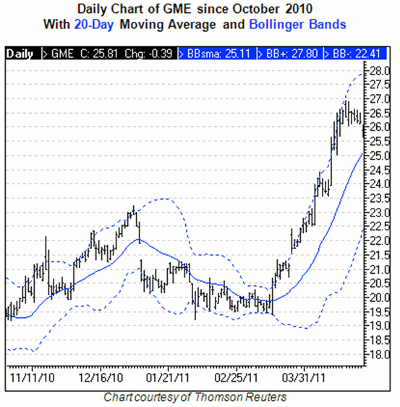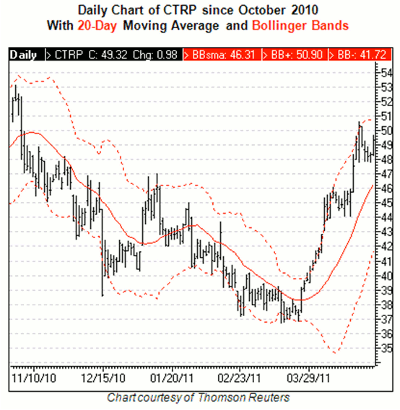A veteran trader discusses key factors to consider when trading option straddles—a favorite earnings season tactic—including important risk factors and a “dealbreaker” that can wreck your position.
Bryan Sapp is one of the resident options traders at Schaeffer's, and he's earned a reputation as the in-house expert on straddles, those two-legged volatility plays that are on the tip of everyone's tongue during earnings season.
But should you really buy a straddle ahead of earnings, when volatility is likely to be higher than usual? And how do you know when you've found a good candidate for a potential straddle trade?
In this Q&A, Bryan explains everything you need to know before trying your hand at a straddle. Read on to learn which technical and sentiment indicators you must check before placing a trade, as well as the one potential dealbreaker that could throw a wrench in your spread strategy.
Elizabeth Harrow: What kind of trader should consider buying straddles?
Bryan Sapp: Virtually anyone can trade straddles, and they can be structured aggressively, conservatively, directionally, or market-neutral.
A straddle is the simultaneous purchase of both a call and put option of the same strike. When purchasing multiple options, you are expecting the stock to make a big enough move to offset the double premium that you are paying. The worst-case scenario for a straddle buyer is for a stock to make no directional move.
Straddles can be of any duration, depending upon the trader's outlook for the particular stock. At Schaeffer’s Investment Research (SIR), we typically focus on the four-to-eight-week time frame, as we've found that to be the "sweet spot" for double-premium buying.
There are some instances where we've traded straddles with a week or less until expiration, and there have also been times where we've purchased straddles four months ahead of expiration. Option prices will always reflect their relative time frame because of the Black-Scholes option pricing model.
Do you prefer to play straddles around events, or are you typically looking for a technical breakout of some kind?
There are times when playing pre-event straddles can make sense, but I typically prefer to play around these events.
An "event" could be the stock's quarterly earnings report, an FDA ruling for a biotech stock, or a Federal Reserve rate decision. Almost always, implied volatilities on options affected by a particular event will be high (making the options expensive), which is the market's way of saying that volatility is expected on the near horizon.
There are some instances where events will go seemingly unnoticed by the market, and implied volatilities will be relatively low—and that is an instance where playing straddles around an event really makes sense.
It is the trader's job to find these opportunities and interpret when and by how much the market has misjudged the potential for a surprise.
Do you ever recommend buying straddles ahead of earnings?
Straddles ahead of earnings can sometimes make sense. This is where the Schaeffer's Volatility Index (SVI) really helps with our trading. This indicator takes the current option premiums and compares them to all premiums during the past year. So, you can look at the current SVI compared to previous pre-earnings levels to see if options are "cheap" as compared to previous quarters.
If you can find a situation where options are relatively cheap on a stock that typically makes big moves on its quarterly earnings reports, playing a straddle could make sense.
One thing to be very aware of is that volatility will implode after the earnings report. Because options are priced as a function of volatility and time, you run the risk of realizing a large loss should the stock not react significantly.
NEXT: Favorable Technical Set-ups to Watch for
|pagebreak|What kind of technical set-up do you like to see for a potential straddle candidate?
There are a handful of technical set-ups that I love to see when looking for straddle candidates. By nature, volatility tends to "cluster." What this means is that periods of high volatility are typically followed by times of low volatility, and vice versa.
I love finding stocks that are historically volatile, but have since entered a coma and traded in a range over a period of time. While this may sound like a sort of voodoo magic, there really is some substance behind it.
One of the technical indicators that I use to identify a stock that is about to make a big move is pinched Bollinger bands. Bollinger Bands are drawn by taking a stock's 20-day moving average and calculating two standard deviations above and below this trend line.
Very wide Bollinger Bands will indicate a period of volatility expansion, and narrow ones will identify a period of volatility contraction. As a straddle trader, you like seeing periods of contraction to an extreme, which will oftentimes precede a period of sharp volatility expansion.
Many trading platforms will have the option of plotting Bollinger Bands above and below the chart. If you can find a stock whose Bollinger bands are at their narrowest point during the past year, then that could be a good sign of a big impending move.
One caveat, however, is that companies that are acquired will trade very close to the acquisition price, so always be sure to check the headlines on a stock to see if there's a particular reason why it is trading in a sideways range.
In addition to Bollinger bands, I try to overlay the option premiums and historical volatility of a stock to search for cheap options. I already mentioned the SVI, which places current short-term options in historical context. Additionally, traders can compare the average moves made by stocks to their typical options premiums.
For example, stocks that have moved disproportionately more than their option premiums indicate will have a high score, and stocks that don't move as much as their option premiums indicate will have a low score. Zero is the lowest possible score, while 100 is the highest.
Sentiment analysis is just as important to trading straddles as it is when you're buying just one option. A trader always needs to know the market's level of exuberance or despair toward a particular stock. This can be examined through indicators such as short interest and analyst ratings.
When trading straddles, it is preferable to find a stock with a very high short interest (and trending higher), and either predominantly neutral or very heavily slanted analyst ratings. A high short-to-float ratio typically means that the bears are in control of a stock, but that can change in an instant.
Should the stock have a positive catalyst, these shorts will need to cover their positions, which can spark a swift, furious rally. Additionally, with the analyst ratings, it is nice to see many "hold" ratings or an extreme consensus on one side. This indicates the potential for analyst capitulation, which could act as a catalyst for the stock.
Next, we'll review a few examples of successful straddle trades we've played, where sideways consolidation moves have preceded big moves by the stock.
Article Continues on Page 3
|pagebreak|Gamestop (GME): Notice how tightly the Bollinger bands were pinched in early March. This was an extreme reading, and it preceded a 35% move by the stock in only one month. At the time we placed the trade, over 27% of GME's float was sold short. This is a great example of what can happen during a short-covering rally.
Ctrip.com (CTRP): Once again, the Bollinger bands were constricted to an extremely low level, the stock had a high short-to-float ratio, and options were priced in the bottom 15% of all readings taken during the past 52 weeks, per the Schaeffer's Volatility Index. The stock rallied 35% from top to bottom in less than a month.
Is there any indicator—technical, sentiment, or otherwise—that you would consider a "dealbreaker," where you would definitely not consider buying a straddle?
I typically try to avoid stocks with a low short-to-float ratio when trading straddles. There are a couple of investing vehicles where this rule doesn't hold true, though.
At Schaeffer's, we've had success in the past playing straddles on TLT, SLV, SLW, and GLD, none of which had high short interest. However, these stocks and ETFs are all related to macroeconomic policy (bonds, silver, and gold stocks), and an event such as a Fed rate decision can have a similar effect to a short-covering rally on these equities. Because of this, it sometimes makes sense to ignore the "rule" of only trading highly shorted stocks.
If a stock is trading between two option strikes, how do you determine your focus strike for a straddle?
This is a situation that you will frequently encounter when trading stocks without single-point option strikes. As a result, you have to play a directional lean.
Typically, it is best to go with the trend. If the stock is consistently making higher highs and lower lows, then taking a bullish lean would make the most sense.
Also, stocks that outperform the broad market over time will generally break down at a faster rate than those that have underperformed over that same time period. Because of this, a failed bullish straddle can quickly see profits, even though you may have been completely wrong about the direction of the move.
By Elizabeth Harrow, contributor, Schaeffer’s Trading Floor Blog





















